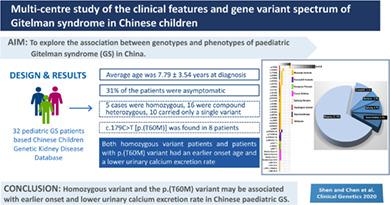当前位置:
X-MOL 学术
›
Clin. Genet.
›
论文详情
Our official English website, www.x-mol.net, welcomes your
feedback! (Note: you will need to create a separate account there.)
Multi‐centre study of the clinical features and gene variant spectrum of Gitelman syndrome in Chinese children
Clinical Genetics ( IF 2.9 ) Pub Date : 2020-12-31 , DOI: 10.1111/cge.13913 Qian Shen 1 , Jiemei Chen 2, 3 , Minghui Yu 1 , Zhi Lin 3, 4 , Xiaojuan Nan 2 , Beijun Dong 2 , Xiaoyan Fang 1 , Jing Chen 1 , Guixia Ding 5 , Aihua Zhang 5 , Chunlin Gao 6 , Li Miao 7 , Yuanyuan Xu 8 , Xiaoyun Jiang 8 , Haitao Bai 9 , Jieqiu Zhuang 10 , Xiaojie Gao 2 , Hong Xu 1 ,
Clinical Genetics ( IF 2.9 ) Pub Date : 2020-12-31 , DOI: 10.1111/cge.13913 Qian Shen 1 , Jiemei Chen 2, 3 , Minghui Yu 1 , Zhi Lin 3, 4 , Xiaojuan Nan 2 , Beijun Dong 2 , Xiaoyan Fang 1 , Jing Chen 1 , Guixia Ding 5 , Aihua Zhang 5 , Chunlin Gao 6 , Li Miao 7 , Yuanyuan Xu 8 , Xiaoyun Jiang 8 , Haitao Bai 9 , Jieqiu Zhuang 10 , Xiaojie Gao 2 , Hong Xu 1 ,
Affiliation

|
Based on the Chinese Children Genetic Kidney Disease Database (CCGKDD), we established a pediatric Gitelman syndrome (GS) cohort to explore the phenotype and genotype characteristics. Thirty‐two patients with SLC12A3 gene variants were collected. Five cases (16%) were homozygous, 16 (50%) were compound heterozygous, 10 (31%) carried only a single variant, and the other one harbored two de novo variants beyond classification. p.(T60M) was found in eight patients. The average diagnosis age was 7.79 ± 3.54 years. A total of 31% of the patients were asymptomatic. Muscle weakness was the most common symptom, accounting for 50%. Earlier age of onset (4.06 ± 1.17 yr vs. 8.10 ± 3.46 yr vs. 8.61 ± 3.56 yr, p< 0.05) and lower urinary calcium‐creatinine ratio (p = 0.024) were found in the homozygous group than those in the heterozygous and compound heterozygous group. Patients with p.(T60M) variant had an earlier age of onset (4.01 ± 2.83 yr vs. 6.92 ± 3.07 yr, p = 0.025) and lower urinary calcium‐creatinine ratio (p = 0.056). Thus, more than 30% of GS children have no clinical symptoms. Homozygous variant and the p.(T60M) variant may be associated with earlier onset and lower urinary calcium excretion in Chinese pediatric GS.
更新日期:2021-03-05











































 京公网安备 11010802027423号
京公网安备 11010802027423号